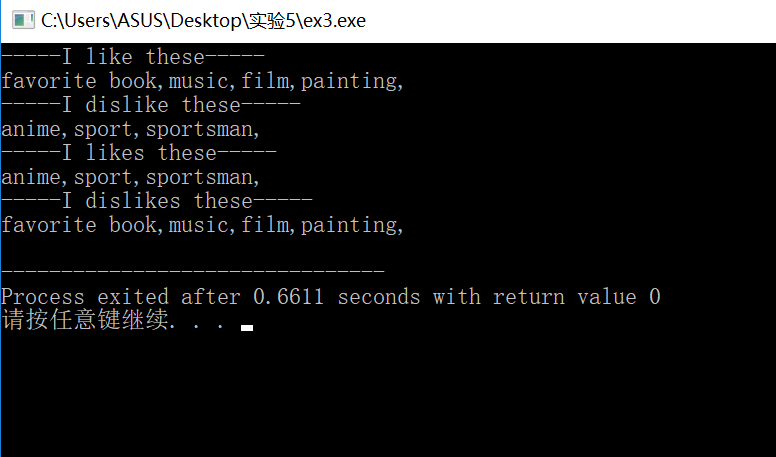1.ex3.cpp完整程序及运行截图
1 #include <iostream> 2 #include <vector> 3 #include <string> 4 using namespace std; 5 6 // 函数声明 7 void output1(vector<string> &); 8 void output2(vector<string> &); 9 10 int main() 11 { 12 vector<string>likes, dislikes; // 创建vector<string>对象likes和dislikes 13 14 // 为vector<string>数组对象likes添加元素值 ( favorite book, music, film, paintings,anime,sport,sportsman,etc) 15 // 补足代码 16 // 。。。 17 likes.push_back("favorite book"); 18 likes.push_back("music"); 19 likes.push_back("film"); 20 likes.push_back("painting"); 21 22 cout << "-----I like these-----" << endl; 23 // 调用子函数输出vector<string>数组对象likes的元素值 24 // 补足代码 25 // 。。。 26 output1(likes); 27 28 29 // 为vector<string>数组对象dislikes添加元素值 30 // 补足代码 31 // 。。。 32 dislikes.push_back("anime"); 33 dislikes.push_back("sport"); 34 dislikes.push_back("sportsman"); 35 36 cout << "-----I dislike these-----" << endl; 37 // 调用子函数输出vector<string>数组对象dislikes的元素值 38 // 补足代码 39 // 。。。 40 output2(dislikes); 41 42 43 // 交换vector<string>对象likes和dislikes的元素值 44 // 补足代码 45 // 。。。 46 likes.swap(dislikes); 47 48 49 cout << "-----I likes these-----" << endl; 50 // 调用子函数输出vector<string>数组对象likes的元素值 51 // 补足代码 52 // 。。。 53 output2(likes); 54 55 cout << "-----I dislikes these-----" << endl; 56 // 调用子函数输出vector<string>数组对象dislikes的元素值 57 // 补足代码 58 // 。。。 59 output1(dislikes); 60 61 62 return 0; 63 } 64 65 66 // 函数实现 67 // 以下标方式输出vector<string>数组对象v的元素值 68 void output1(vector<string> &v) { 69 // 补足程序 70 // 。。。 71 for(int i=0;i<v.size();i++) 72 cout<<v[i]<<","; 73 cout<<endl; 74 } 75 76 // 函数实现 77 // 以迭代器方式输出vector<string>数组对象v的元素值 78 void output2(vector<string> &v) { 79 // 补足程序 80 // 。。。 81 vector<string>::iterator it1=v.begin(); 82 vector<string>::iterator it2=v.end(); 83 for(;it1!=it2;it1++) 84 cout<<*it1<<","; 85 cout<<endl; 86 }

2.关于6-17程序的修改
1 #include<iostream> 2 using namespace std; 3 int main() 4 { 5 int *p; 6 p=new int(9); 7 cout<<"The value at p:"<<*p; 8 delete p; 9 return 0; 10 }
3.关于6-18程序的修改
1 #include<iostream> 2 using namespace std; 3 int fn1(){ 4 int *p=new int(5); 5 int reserve=*p; 6 delete p; 7 return reserve; 8 } 9 int main(){ 10 int a=fn1(); 11 cout<<"the value of a is:"<<a; 12 return 0; 13 }
这道题一开始没看出什么问题,参考了同学的博客修改的。
书p219 注意 “用new 分配的内存,必须用delete加以释放,否则会导致动态分配的内存无法回收,使得程序占据的内存越来越大,这叫做‘内存泄漏’。”